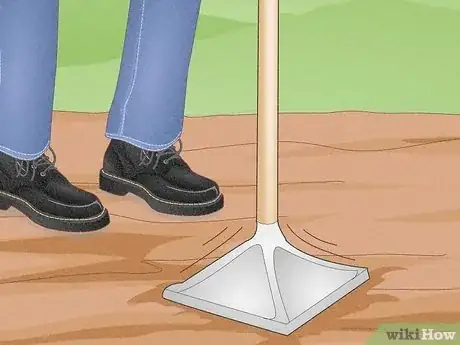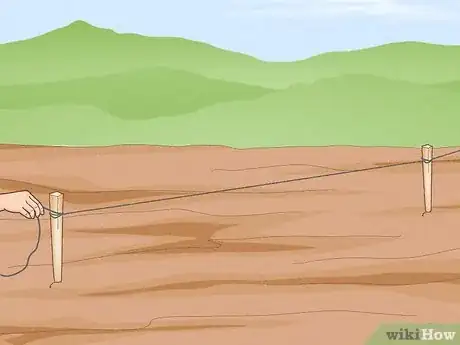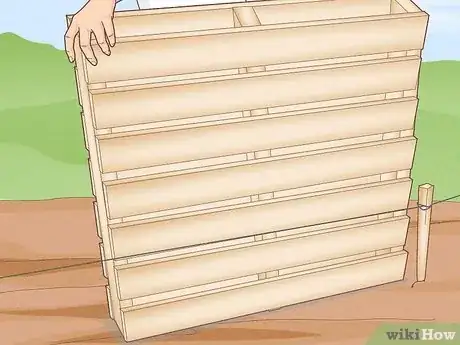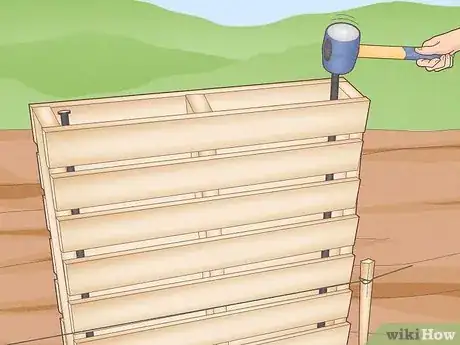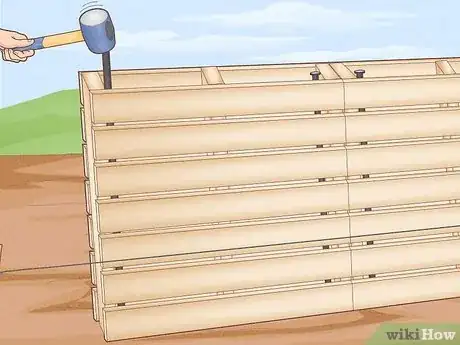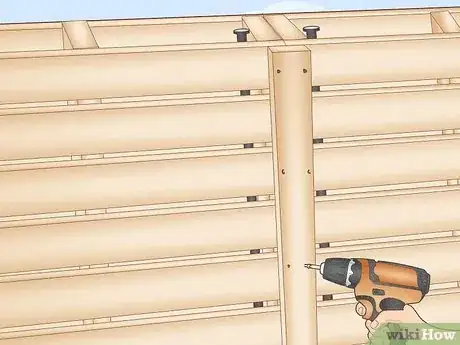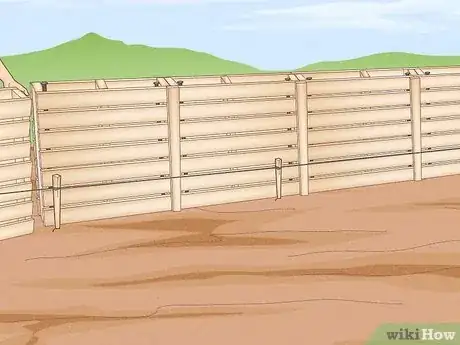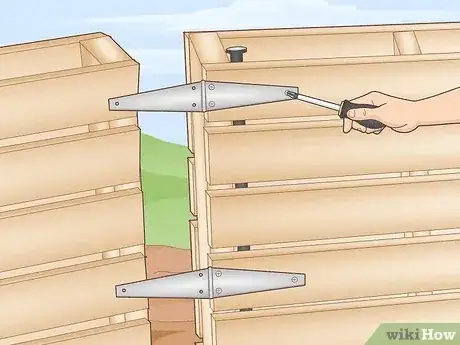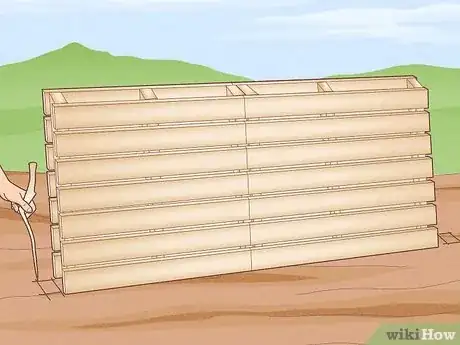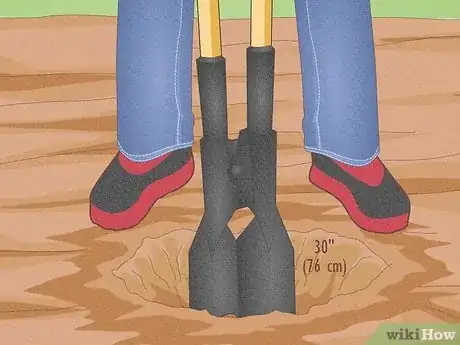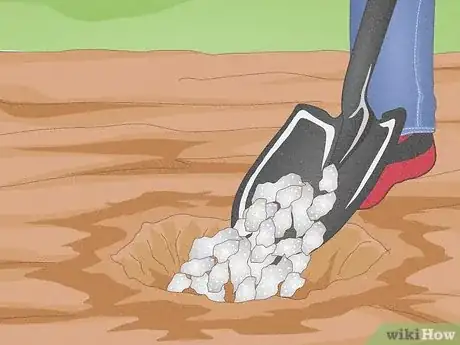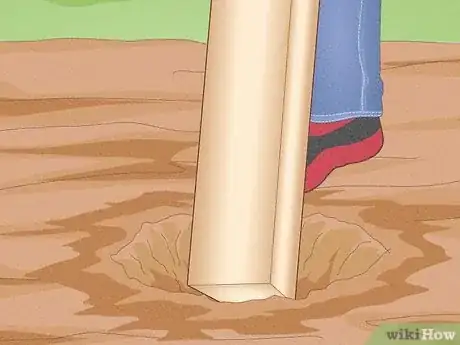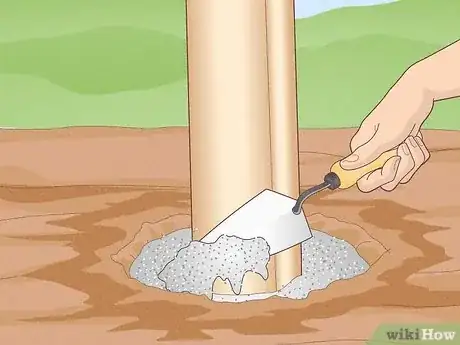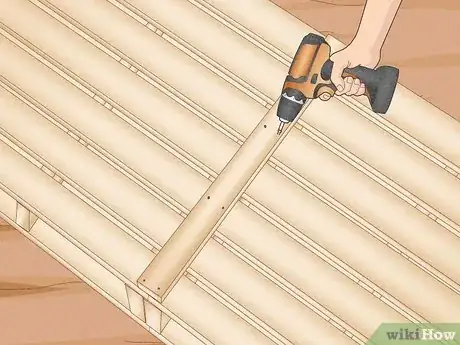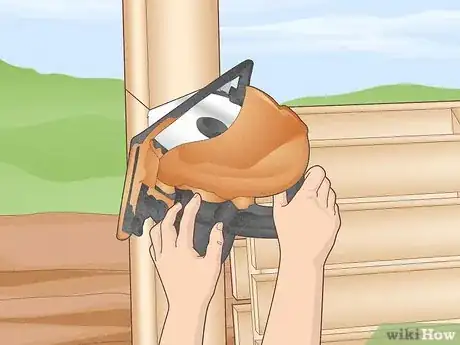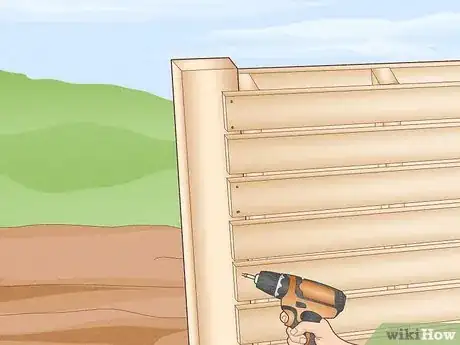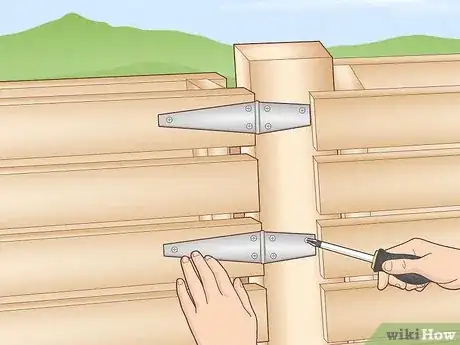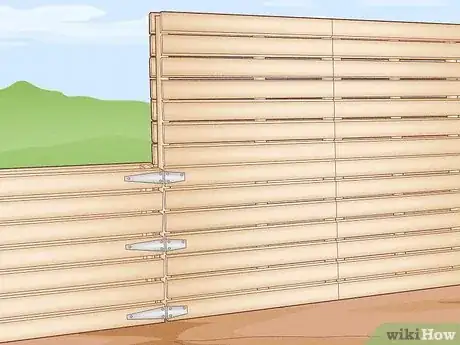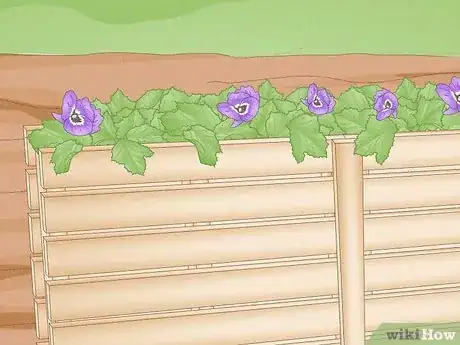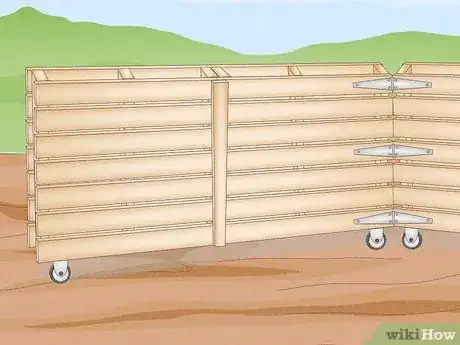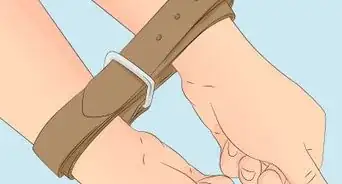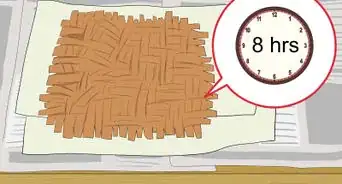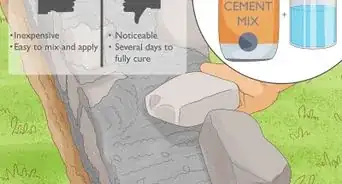This article was co-authored by Sina Kamran and by wikiHow staff writer, Christopher M. Osborne, PhD. Sina Kamran is a Hardscaping Specialist and the Owner of Design Scapes, Inc. in Santa Monica, California. With over 15 years of experience, he specializes in customized, site-specific hardscaping and landscaping design/build projects. He's a certified National Concrete Masonry Association (NCMA) designer, a certified installer with the Interlocking Concrete Pavement Institute (ICPI), and a Rain Bird Certified Irrigation Professional. Additionally, Design Scapes, Inc. has many 5-star rated reviews.
There are 11 references cited in this article, which can be found at the bottom of the page.
This article has been viewed 5,577 times.
If you’re looking for a relatively short but fairly sturdy fence with a rustic flair and a low cost for materials, why not pick up some old pallets from a nearby warehouse or store? Of course, you can’t just stand the pallets upright and call it a fence, so we’ll show you how to secure both a less-permanent and more-permanent pallet fence. Before you know it, you’ll have a line of DIY pallet fencing that you’ll be proud to show off!
Things You Should Know
- Build a less-permanent pallet fence by driving pound-in metal fence posts between the slats at the ends of the upright pallets.
- Erect a more-permanent pallet fence by setting fence posts in concrete and attaching pairs of pallet fence panels to them.
- Build a privacy fence by stacking 2 pallets on top of each other, or add planter boxes to your fence for an easy decoration.
Steps
Pound-in Post Fence
-
1Level—or at least flatten—the ground along the intended fence line. The pallets rest on the ground with this quicker and less permanent DIY method, so use a shovel to remove any vegetation and smooth out the ground where the fence will sit. You can build this kind of fence on ground that has a gentle, even slope, but you’re better off installing permanent fence posts with concrete if you want to build a pallet fence on steeper or uneven ground.[1]
-
2Mark the perimeter of your fence with a string line and stakes. Pound wooden stakes in the ground on the outer edge of all ends and corners of your fence line, as well as about every 10 ft (3.0 m) or so in between. Run a string between the stakes, wrapping it around each stake so that it’s toward the inside (fence side) of the stake.[2]
- You can skip this step if you want, but you’ll be surprised by how easy it is to end up building a leaning or wavy fence without realizing it!
Advertisement -
3Stand the first pallet upright, slats horizontal, along the string line. Position the pallet so that the outside of it just touches up against the string line. If the pallet won’t stand up straight, move it out of the way and use your shovel to level out the ground some more. (Or, have someone else hold the pallet in position while you take care of the next step.)[3]
- Putting the pallet’s slats in a horizontal position means that there is solid wood along the vertical sides where the pallet fence panels meet together. Putting the slats vertical leaves open gaps (meant for forklift tines) along the vertical sides.
-
4Drive a metal fence post into the ground, just inside the pallet’s edge. Slip the end of the pound-in metal fence post with the arrow-shaped blade into the opening at the top of the pallet, right alongside the vertical wood that runs along the vertical edge of the pallet.[4] Drive the post down into the ground with a small sledgehammer or a post driver until the blade is fully underground.[5]
- For a “kind of sturdy” fence, drive in only one post, on the edge of the pallet that is either the endpoint or a corner of the fence.
- For a “pretty sturdy” fence, drive in two posts, one on each edge of the pallet.
- For a “really sturdy” fence, check out the other method in this article!
- To build a fence made of typical 40 in × 48 in (100 cm × 120 cm) pallets, use 5 ft (1.5 m) metal fence posts.
-
5Line up a second pallet and secure it with another fence post. Lift and slide the second pallet into place so that it’s just touching the string line and is butted up right against the first pallet. Drive another fence post into the ground against the inside edge of the second pallet—on the side furthest from the meeting point with the first pallet.[6]
- Try to keep the second pallet lined up while you pound in the post, but don’t worry if it moves a little. You’ll be attaching it to the first pallet shortly.
- If you’re looking to build that “pretty sturdy” fence instead, go ahead and drive 2 posts into the second pallet, one at each end.
-
6Connect the pallets with cut-to-length 2x4s and screws. Cut 2 boards of 2x4 lumber so that each one is equal in length to the height of the pallet fence. Stand up one of the boards and line it up over top of the joint where the 2 pallets meet. Drill at least 8 pilot holes through the 2x4 board (at least 4 apiece into each pallet), then drive 2.5 in (6.4 cm) screws through the board and into the pallets.[7]
- Repeat the process on the opposite side of the fence with the other board.
-
7Repeat the process along your fence line. Installing a pallet fence this way is mostly just a repetitive process of lining up the pallets, pounding in posts, and screwing together the pallet fence panels. But here are a few complications you might face:[8]
- Corners: Line up the 2 pallets at a 90-degree angle so that one overlaps the edge of the other at the corner. Drill through each of the interior slats of the overlapping pallet and into the side vertical support of the covered pallet, then drive in 2.25 in (5.7 cm) screws.
- Cut pallets: If you need to cut a pallet to fit your fencing area, aim to cut through the horizontal slats right up alongside the vertical support that runs up the center of the pallet. You’ll basically end up with a half-width pallet fence panel that will install in the same fashion.
- Gates: Check out the next step!
-
8Attach a pallet gate with hinges, if needed. A gate on a pound-in post pallet fence will inevitably be a little wobbly, so you may want to consider setting the gate posts in concrete (if so, see the next section). But, if you prefer to stick with the pound-in method, do the following:[9]
- Leave the gap for the gate opening about 1–2 in (2.5–5.1 cm) wider than the width of a pallet.
- Secure the pallets on either side of the gate opening with 2 pound-in posts apiece.
- Lay scraps of wood on the ground to prop up the gate pallet about 1–2 in (2.5–5.1 cm) off the ground.
- Screw in at least 3 gate hinges on one side of the gate pallet and the fence pallet beside it.[10]
- Install the gate latch on the side of the gate pallet opposite to the hinges.
Permanent Post Fence
-
1Mark the fence post locations based on the width of your pallets. If you’re using common 40 in × 48 in (100 cm × 120 cm) pallets, for example, lay out the fence posts so that there is 80 in (200 cm) of open space—the width of 2 pallets—between each post. That way the pallets will slip right into place when it’s time to attach them to the posts.[11]
- If you’re making a gate opening, leave only 41–42 in (100–110 cm) of space between a pair of fence posts in that location.
-
2Dig holes for the fence posts that are at least 30 in (76 cm) deep. Use a manual post hole digger or power auger to dig post holes that are at least 2.5 ft (0.76 m) deep and 12 in (30 cm) in diameter.[12]
- 30 in (76 cm) is typically the minimum digging depth for fence posts, and it works well for a 4 ft (1.2 m) high pallet fence. At this depth—and after adding some crushed stone to the bottom—at least 1/3 of the total length of your 4x4 posts will be buried underground, making for a sturdy fence.
-
3Add at least 4 in (10 cm) of crushed stone to the holes. Pour in some crushed stone, tamp it down with a tamper, and repeat until each hole measures 24–26 in (61–66 cm) deep. The crushed stone enhances stability and drainage at the bottom of each post.[13]
-
4Set the posts in the holes and brace them in position. Put the post in the hole, then attach 2 scrap pieces of 2x4 lumber to adjacent sides of the post, each with a single 2.25 in (5.7 cm) screw, about 18–24 in (46–61 cm) up from the ground. Angle the 2x4s so they’re touching the ground, then drive a wooden stake into the ground right up against each one. Use a level to get the post into the proper alignment, then attach each 2x4 to its stake with a screw.[14]
- Repeat this process with the other posts.
-
5Pour concrete into the post holes and let it cure for 3+ days. Mix the bag of concrete according to the product instructions, then shovel it into the hole surrounding the post. Either fill the fence post hole with concrete up to about 1 in (2.5 cm) below the surface (so you can cover it with soil), or mound it up around the base of the post about 1 in (2.5 cm) above the surface (to help shed water).[15]
- Do the same with all the other posts. Let the concrete set up for at least 3 days (or whatever is recommended on the package) before proceeding.
- If you’re using a quick-set concrete, pour the dry mix into the hole, then pour in water, all according to the specific product instructions.
-
6Screw together 2 pallets side-by-side with the slats lined up. Lay the pallets on flat ground so they line up evenly with the solid wood blocking (found on 2 of the 4 edges of each pallet) butted up together. Reach between the 2 rows of slats on one of the pallets and drill at least 8 pilot holes through the wood blocking. Drive in 3 in (7.6 cm) screws to connect the pallets together.[16]
- Repeat the process with each pair of pallets you’re using.
- If you want to conceal the joints between your pallets, cover each connection with a piece of 1x4 lumber cut to length and screwed or nailed into place.
-
7Cut the tops of the fence posts to an even height. Add 2 in (5.1 cm) to the height of your pallets—for example, 50 in (130 cm) for 48 in (120 cm) pallets—and measure up from ground level for each post. Cut the posts to that height with a circular saw or other saw of your choice.[17]
- The extra 2 in (5.1 cm) is for ground clearance so that your pallets are flush with the top of the posts but not touching the ground.
-
8Slip the paired pallets between 2 posts and screw them in place. Use scraps of wood to prop up the 2-pallet panel off the ground and line it up with the tops of the posts. Reach in between the pallet slats to drill pilot holes and drive 2.25 in (5.7 cm) screws through the pallet structure and into the posts. Drive in at least 6 screws per side.[18]
- While it’s possible to do this job solo, it’ll definitely be easier with a second (and even third) set of hands!
- Repeat the process with the remaining posts and paired pallet panels. Once you get into a groove, you’ll be surprised just how quickly your fence comes together.
-
9Use hinges and latches to create a pallet gate if you need one. Assuming you planned ahead properly, your gate opening should be about 42 in (110 cm) wide (if you’re using common pallets) and have sturdy posts at each end. Here’s how to turn a single pallet into the gate for this opening:[19]
- Use scraps of wood to prop up the gate pallet about 1–2 in (2.5–5.1 cm) off the ground and level with the fence posts.
- Screw in at least 3 gate hinges on one of the gate posts and the gate pallet beside it.[20]
- Install the gate latch on the side of the gate pallet opposite to the hinges.
Pallet Fence Ideas
-
1Double-height privacy fence: If you’re using the permanent post fence method, it’s relatively easy to double the height of the fence to 96 in (240 cm). Simply use longer 4x4 posts and cut them to 98 in (250 cm) after installation, and stack one pallet on top of another to create the higher fence. Connect the pallets together and to the posts as before.[21]
- To make your double-height fence more sturdy, consider setting your posts with 40 in (100 cm) spacing instead of 80 in (200 cm) so that each stacked pair of pallets is secured to two posts.
- Check for any fence height restrictions where you live before building this kind of fence. If you’re limited to a 6 ft (1.8 m) high fence, for example, you’ll have to cut each top pallet in your stacked fence in half.
-
2Pallet fence planters: Many DIYers turn pallets into hanging or leaning planters, and you can use the same technique to create a pallet fence with a row of planters built into the top. Start by building your fence using either method outlined in this article. The roughly 4 in (10 cm) gap between the horizontal slats at the top of the fence will serve as your planter row. Simply staple landscape fabric in the gap to create a sling that you can fill with potting soil and your favorite flowers.[22]
-
3Pallet fence on wheels: If you’re looking for a temporary fence that you can move from place to place, this may be your solution! Here are the basics:[23]
- Connect a series of pallets side-by-side with gate hinges (2-3 hinges per connection). Alternate the sides of the gate hinges so your standing fence can have a zig-zag (or accordion-style) pattern.
- Install 2 heavy-duty caster wheels on the bottom of each pallet fence panel.
- Stand the fence upright on the wheels and adjust the panels into a zig-zag/accordion pattern so they’re sturdy.
- Wheel the fence into position (this fence works best on a flat, hard surface, such as a patio or driveway).
- When you’re done with the fence, fold the panels flat for storage.
Things You’ll Need
Pound-in Post Fence
- Tape measure
- Shovel
- String line
- Wood stakes
- Small sledgehammer
- Pound-in metal posts
- 2x4 lumber
- Drill
- Screws
Permanent Post Fence
- Tape measure
- Post hole digger
- Crushed stone
- 2x4 lumber
- 4x4 posts
- Drill
- Screws
- Concrete mix
- Saw
Expert Interview
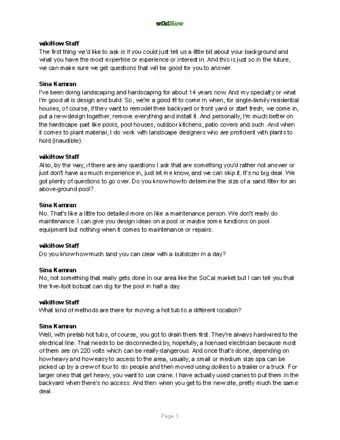
Thanks for reading our article! If you'd like to learn more about landscaping, check out our in-depth interview with Sina Kamran.
References
- ↑ https://homesteady.com/13424994/how-to-build-a-pallet-fence
- ↑ https://howtohardscape.com/how-to-set-up-a-string-line-for-paving/
- ↑ https://homesteady.com/13424994/how-to-build-a-pallet-fence
- ↑ https://homesteady.com/13424994/how-to-build-a-pallet-fence
- ↑ https://youtu.be/-8omFF00gAk?t=419
- ↑ https://homesteady.com/13424994/how-to-build-a-pallet-fence
- ↑ https://homesteady.com/13424994/how-to-build-a-pallet-fence
- ↑ https://homesteady.com/13424994/how-to-build-a-pallet-fence
- ↑ https://homesteady.com/13424994/how-to-build-a-pallet-fence
- ↑ https://www.thisoldhouse.com/fences/21016148/how-to-install-a-fence-gate
- ↑ https://www.organizewithsandy.com/how-to-build-a-pallet-fence-easy-step-by-step-guide/
- ↑ https://www.bobvila.com/articles/installing-fence-posts/
- ↑ https://www.thisoldhouse.com/fences/21363130/fence-post-installation
- ↑ https://www.outdooressentialproducts.com/en/Projects/How-to-Dig-Post-Holes-and-Set-Fence-Posts
- ↑ https://www.outdooressentialproducts.com/en/Projects/How-to-Dig-Post-Holes-and-Set-Fence-Posts
- ↑ https://www.organizewithsandy.com/how-to-build-a-pallet-fence-easy-step-by-step-guide/
- ↑ https://extremehowto.com/diy-privacy-fence/
- ↑ https://www.organizewithsandy.com/how-to-build-a-pallet-fence-easy-step-by-step-guide/
- ↑ https://homesteady.com/13424994/how-to-build-a-pallet-fence
- ↑ https://www.thisoldhouse.com/fences/21016148/how-to-install-a-fence-gate
- ↑ https://www.organizewithsandy.com/how-to-build-a-pallet-fence-easy-step-by-step-guide/
- ↑ https://www.gardenpatch.co.uk/how-to-make-a-pallet-planter-box/
- ↑ https://homesthetics.net/pallet-fence/
